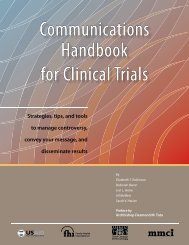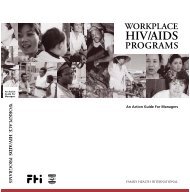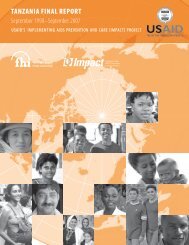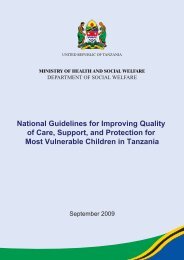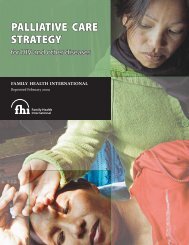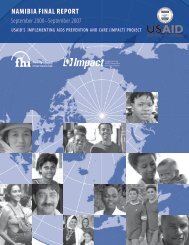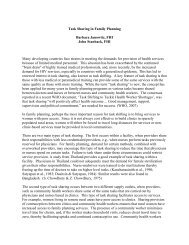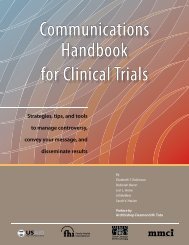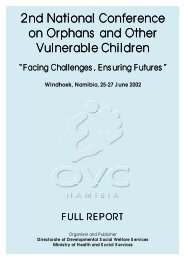ghain support to antiretroviral therapy in nigeria - Family Health ...
ghain support to antiretroviral therapy in nigeria - Family Health ...
ghain support to antiretroviral therapy in nigeria - Family Health ...
You also want an ePaper? Increase the reach of your titles
YUMPU automatically turns print PDFs into web optimized ePapers that Google loves.
DISCUSSION<br />
The challenges of deliver<strong>in</strong>g ART <strong>in</strong> low resource sett<strong>in</strong>gs have been documented,<br />
most notably: shortages of health care staff; <strong>in</strong>adequate drug procurement and<br />
labora<strong>to</strong>ry capacity; weak health facility <strong>in</strong>frastructure; and <strong>in</strong>efficient health<br />
data management systems (Coetzee D et al 2004, Lawn SD et al 2010, Van DW et al<br />
2006). The GHAIN ART program faced significant challenges dur<strong>in</strong>g its implementation.<br />
The pr<strong>in</strong>cipal challenge was the weak health systems and substantial shortages of skilled<br />
staff at participat<strong>in</strong>g facilities. Low staff morale was tackled by provid<strong>in</strong>g non-monetary<br />
<strong>in</strong>centives like awards for outstand<strong>in</strong>g staff and high perform<strong>in</strong>g sites. Pre-implementation<br />
<strong>in</strong>frastructure was often poor and dilapidated. GHAIN addressed these by rehabilitat<strong>in</strong>g<br />
the <strong>in</strong>frastructure at various service delivery po<strong>in</strong>ts and<br />
procured new and replaced broken down equipments<br />
for the labora<strong>to</strong>ry. Genera<strong>to</strong>rs were provided <strong>to</strong><br />
ensure un<strong>in</strong>terrupted power supply. Boreholes were<br />
sunk <strong>in</strong> some sites <strong>to</strong> ensure facilities have access<br />
<strong>to</strong> potable water. The health <strong>in</strong>formation and supply<br />
cha<strong>in</strong> management systems were weak. The project<br />
strengthened these systems through capacity build<strong>in</strong>g<br />
for exist<strong>in</strong>g staff and develop<strong>in</strong>g tailor-made <strong>to</strong>ols<br />
<strong>in</strong>clud<strong>in</strong>g electronic medical record systems such as LAMIS and a logistics management<br />
<strong>in</strong>formation system (LMIS) <strong>to</strong> enhance moni<strong>to</strong>r<strong>in</strong>g.<br />
Evidence of positive cl<strong>in</strong>ical outcomes of ART patients managed at primary cl<strong>in</strong>ics has been<br />
reported by several studies (Coetzee D et al 2004, Shumbusho et al 2009, Str<strong>in</strong>ger et al<br />
2006, Zachariah et al 2009). The GHAIN project piloted decentralization of ART services<br />
from secondary level facilities <strong>to</strong> primary health centers <strong>in</strong> Nigeria. This was done primarily<br />
<strong>to</strong> address the challenge of congestion at the secondary sites and <strong>to</strong> take services closer<br />
<strong>to</strong> the communities were patients live. Two sites; General Hospital Calabar, Calabar South<br />
LGA of Cross River State and Infectious Disease Hospital Kano, Nasarawa LGA, Kano State<br />
were <strong>in</strong>volved <strong>in</strong> decentralization of ART services <strong>to</strong> five primary health centers <strong>in</strong> the same<br />
local government areas of each state.<br />
END OF PROJECT MONOGRAPH<br />
GHAIN SUPPORT TO ANTIRETROVIRAL THERAPY IN NIGERIA<br />
13



